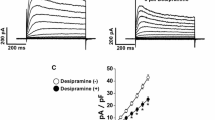Abstract
Enzymatically dispersed smooth muscle cells of the guinea-pig portal vein were studied by the patch-clamp technique. They were found to have Ca2+-dependent K+ channels with the typical properties of the “BK” channel, i.e. a reversal potential at the calculated equilibrium potential for K+ ions, a striking voltage dependence, and a conductance of approximately 200 pS ([K+]0 50 mM, [K+]i 150 mM, positive patch potentials). Tedisamil, a new bradycardic agent with an inhibitory action on K+ currents in heart muscle, reduced the open probability of the BK channels concentration-dependently (1–100 μM) when applied at the cytosolic side of membrane inside-out patches. At 100 μM [Ca2+]i, the IC50 of tedisamil was 13.8 μM (¯x, n=5). Tedisamil increased the frequency of channel closures, and reduced the mean duration of openings from 8 ms to < 1 ms, while the mean duration of closures within bursts (1–2 ms) was not altered. Tedisamil did not affect long closures (> 160 ms) between bursts, either. The mean time of residence of tedisamil at the BK channel was estimated to be 1–2ms. Hence, tedisamil, in comparison to the “slow” blocker Ba2+ and the “fast” blocker tetraethylammonium, holds the position of an “intermediate” K+ channel blocker.
Similar content being viewed by others
References
Armstrong CM (1966) Time course of TEA+-induced anomalous rectification in squid giant axons. J Gen Physiol 50:491–503
Benham CD, Bolton TB, Lang RJ, Takewaki T (1985) The mechanism of action of Ba2+ and TEA on single Ca2+-activated K+-channels in arterial and intestinal smooth muscle cell membranes. Pflügers Arch 403:120–127
Colquhoun D, Hawkes AG (1983) The principles of the stochastic interpretation of ion-channel mechanisms. In: Sakmann B, Neher E (eds) Single-channel recording. Plenum Press, New York, pp 135–176
Duchosal F, Opie LH (1987) KC 8857, a new compound with combined bradycardic and positive inotropic effects. J Mol Cell Cardiol 19[Suppl III]:19
Dukes ID, Morad M (1989) Tedisamil inactivates transient outward K+ current in rat ventricular myocytes. Am J Physiol 257:H1746-H1749
Dukes ID, Cleeman L, Morad M (1990) Tedisamil blocks the transient and delayed rectifier K+ currents in mammalian cardiac and glial cells. J Pharmacol Exp Ther 254:560–569
Grohs JG, Fischer G, Raberger G (1989) Cardiac and hemodynamic effects of the selective bradycardic agent KC 8857 during exercise-induced myocardial ischemia. Eur J Pharmacol 161:53–60
Hamill OP, Marty A, Neher E, Sakmann B, Sigworth FJ (1981) Improved patch-clamp techniques for high-resolution current recording from cells and cell-free membrane patches. Pflügers Arch 391:855–1000
Hille B (1984) Ionic channels of excitable membranes. Sinauer Associates, Sunderland, Mass.
Inoue R, Kitamura K, Kuriyama H (1985) Two Ca-dependent K-channels classified by the application of tetraethylammonium distribute to smooth muscle membranes of the rabbit portal vein. Pflügers Arch 405:173–179
Klöckner U, Isenberg G (1989) The dihydropyridine niguldipine modulates calcium and potassium currents in vascular smooth muscle cells. Br J Pharmacol 97:957–967
Kühl UG, Buschmann G (1987) Cardiovascular profile of KC 8857 in comparison with other cardioactive agents. J Mol Cell Cardiol 19[Suppl III]:50
Marty A, Neher E (1985) Potassium channels in cultured bovine adrenal chromaffin cells. J Physiol (Lond) 367:117–141
Maruyama I, Yoshida C, Kobayashi M, Oyamada, H, Momose K (1987) Preparation of single smooth muscle cells from guinea pig taenia coli by combinations of purified collagenase and papain. J Pharmacol Methods 18:151–161
Noack T, Deitmer P, Golenhofen K (1990) Features of a calcium independent, caffeine sensitive outward current in single smooth muscle cells from guina pig portal vein. Pflügers Arch 416:467–469
McCann JD, Welsh MJ (1987) Neuroleptics antagonize a calcium-activated potassium channel in airway smooth muscle. J Gen Physiol 89:339–352
Michel GLA, Lenz T, Lernhardt U, Weicker H, Bieger W, Werle E (1987) Sulfoconjugated catecholamines: lack of β-adrenoceptor binding and adenylate cyclase Stimulation in human mononuclear leukocytes. Eur J Pharmacol 143:179–188
Mironneau J, Savineau JP, Rahéty A (1977) Evidence for a component of the outward current mediated by calcium influx in uterine smooth muscle. In: Casteels R, Godfraind T, Rüegg JC (eds) Excitation-contraction coupling in smooth muscle. Elsevier/North Holland Biomedical, Amsterdam, pp 117–129
Neher E (1983) The charge carried by single-channel currents of rat cultured muscle cells in the presence of local anaesthetics. J Physiol (Lond) 339:663–678
Oexle B, Weirich J, Antoni H (1987) Electrophysiological profile of KC 8857, a new bradycardic agent. J Mol Cell Cardiol 19 [Suppl III]:65
Singer JJ, Walsh JV (1987) Characterization of calcium-activated potassium channels in single smooth muscle cells using the patch-clamp technique. Pflügers Arch 408:98–111
Stuenkel EL (1989) Single potassium channels recorded from vascular smooth muscle cells. Am J Physiol 257:H760-H769
Yellen G (1984) Ionic permeation and blockade in Ca2+-activated K+ channels of bovine chromaffine cells. J Gen Physiol 84:157–186
Author information
Authors and Affiliations
Additional information
Supported by the Deutsche Forschungsgemeinschaft
Rights and permissions
About this article
Cite this article
Pfründer, D., Kreye, V.A.W. Tedisamil blocks single large-conductance Ca2+-activated K+ channels in membrane patches from smooth muscle cells of the guinea-pig portal vein. Pflugers Arch. 418, 308–312 (1991). https://doi.org/10.1007/BF00550866
Received:
Revised:
Accepted:
Issue Date:
DOI: https://doi.org/10.1007/BF00550866




